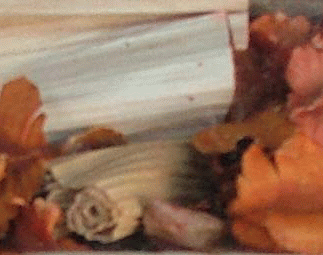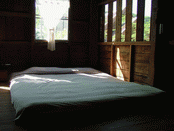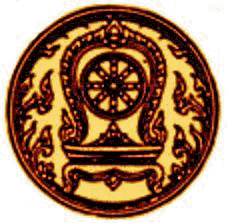|
Baan Hom Samunphrai A Herbal Health Centre & School Chiangmai, Thailand |
||
|
---------INDEX---------
Address: Baan Hom Samunphrai 93/2a Moo 12 Tawangtan, Saraphi, Chiang Mai 50140, THAILAND
tel. 053-817-362 (English & Thai) tel. 081.885.1429 (Homprang direct)
e-mail:
---------INDEX--------- |
MORE ABOUT THE WEATHER IN CHIANG MAI (averages: low 25° C = 74° F; high 34° C = 93° F; short rain every day.) November 1st, 2025: When does the Dry or 'Cool' Season Begin? Each year the 'Dry' or 'Cool' Season begins toward the end of October with cool nights and perfect days and stays like that for 3 months. There are a few misty mornings and even occasional light showers, and the nights are cool enough to warrant slipping on a light pullover. Blissful. On the other hand, the "dryness" of the Dry Season eventually causes the temperatures to rise again, and in March Thailand enters the hottest period of the year, until the Monsoon returns in May or early June. The rains then clean the air and the sky is blue again with puffy white cumulus clouds, and brilliant sunsets. During the Rainy Season the air is clean and moist and we feel the heat much less. nd rain is blissful too! What We Are Doing About the Heat. Like everywhere else in the world it is certainly hotter here in Thailand than it used to be, and we're doing as much as we can to deal with that. We have not only installed high pressure water sprays around all our open dining and social areas, we have built a beautiful new Training Sala called Baan Rom Yen -- that means 'Cool House' in Thai, with all the same special feelings the word 'cool' has in English. In addition to air-conditioning, Baan Rom Yen has an air-purifying system that brings in fresh air from the outside, so the inside 'conditioned' air never grows stale. We use it whenever it is necessary, regardless of the season. Some background on the Heat and Smoke in Chiang Mai. We have two advantages over the local weather reports. The first is that we are 9 kms outside the city in what is still an agricultural area that uses lots of water for irrigation. The humidity not only brings down the temperature but also purifies the air. Another important factor in our favor is that there is no heavy industry in the North of Thailand. The people are largely farmers, and they are the ones who make the smoke as they traditionally burn the rice paddies after the harvest in February and March. In addition, the Hill Tribe people burn parts of the forest to prepare new areas for cultivation, an ancient jungle practice called 'slash-and-burn agriculture.' The smoke and dust in March, April and May can be a problem, but it's not the perennial 'smog' that hangs over most of the urban and industrial centers in more developed parts of the world. Burning anything in public is now illegal in Thailand. On the other hand, the farmers have always used burning to improve the fertility of the soil, and neither the rice farmers nor the Hill Tribe people are convinced that the authorities know the soil better than they do -- which is very much an unresolved issue. The Rainy or Monsoon Season lasts from May to the end of October, and begins with short but fierce thunder storms. Almost over night the whole South-East-Asian weather system changes from a hot 'Northerly' flow of air passing over the great deserts of Mongolia and China to a 'Southerly' ('Monsoon') flow full of water drawn up from the Indian ocean. Though intense, the rain bursts are short, just for 20 minutes or so, after which the sun comes out again – big, white and very clean clouds with the sun shining strongly between them. Beautiful. Flooding does sometimes happen toward the end of the Rainy Season, but it has only overwhelmed us once, and we have been here for 30 years! Last October (2024) the water in the Ping River reached the highest level ever recorded. The torrent went right over the top of the Rainbow Bridge in Koh Klang, with tree trunks and logs shattering the 'Rainbow' guard rails (those of you who have been here will be able to imagine the height and force of the torrent!). And yes, it went over the top of our own new flood-retaining wall we had just built in 2023. Had we been 3 inches higher we would have stayed dry (we have started to work on that already, don't worry, and so has the Chiang Mai city government. A whole new cement drainage canal is being dug just on the other side of Ginger Farm. For those of you who have never been here that's just 400m. east of us, so we will now be protected on both sides!). Our sincere feeling is that this is unlikely to happen again, that is that another freak Typhoon will arrive right on top of unrelated lows of an intensity and duration the region had never experienced before!!! Yes, we take note -- and yes, we will be raising our flood wall substantially, and making other significant modifications too. We'll be ready! Chiang Mai will also be completing the last major concrete dyke on the lower Ping River this winter -- which is precisely the weak point from which the flood waters overwhelmed us last year. With that job done (just 300 metres to go!!!) our District will be able to handle anything the Weatherman can come up with! Our own priorities are simple. Our bedrooms are in old teak houses on stilts so they never flood. We do not have air-conditioning in them. but the ventilation is very good with overhead fans as well. There are lots of windows with shutters, white cotton curtains and screens -- but no glass! They're beautiful and healthy and most people love them – and we sleep very well. And don't forget, a 'Room of Your Own' is not very important in Thailand, what is more a 'Living Room.' Everybody lives 'outside' all year round here, and you go 'indoors' just to sleep. Even on the very hottest days it cools down rapidly in the evening, particularly in the country -- which is another reason why we all sleep so well.
We hope you will come and see what
we're like sometime soon, and hope that you will agree
with us that where we live is as near to a perfect
environment as human beings deserve!
|











